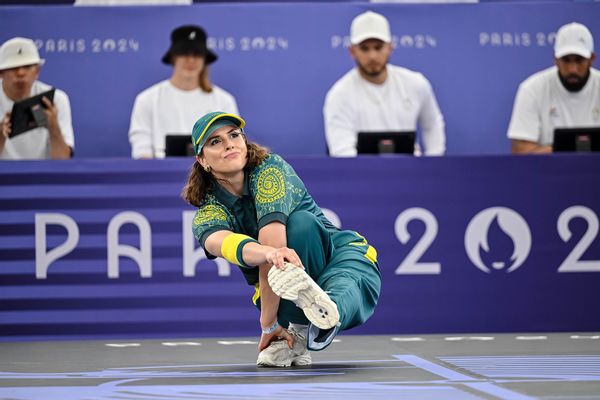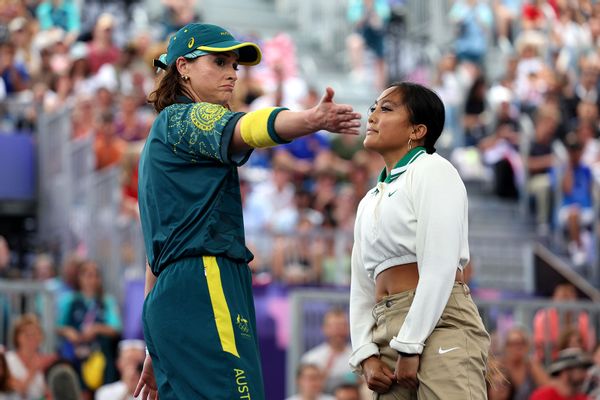
Eddie the Eagle. The Jamaican bobsledding team. Great underdog stories are part of the Olympics’ fabric, giving TV audiences supplemental heroes to cheer on. The most famous of these contenders have the hearts of champions if not the skills — although some, like the 1980 U.S. men’s ice hockey team, which was mainly comprised of amateurs, make history by pulling off miracles.
Rachael Gunn was never going to do that. The 36-year-old college professor said as much after she was eliminated from the Paris Games’ breaking competition that left viewers alternately befuddled, delighted and enraged due to its confident awkwardness.
Gunn, who represented Australia in the b-girls competition under the moniker Raygun, was knocked out in the round-robin competition without scoring a single point. Worse, she was totally fine with that.
“I was never going to beat these girls on what they do best, the dynamic and the power moves, so I wanted to move differently, be artistic and creative, because how many chances do you get in a lifetime to do that on an international stage?” Gunn told reporters after the fact.
Maybe not so many. Or perhaps a lot more.
In her battles, Gunn busted moves like “the kangaroo” and “happy doggo rolling on a lawn,” carrying herself like a combination of Chris Lilley’s “Summer Heights High” character Mr. G and Sacha Baron Cohen’s Ali G.
While other competitors wore their favorite streetwear, Gunn wore her country’s official tracksuit, which made her look like she was ready to either a) sell you some John Deere mowers; or b) assemble a Subway footlong to your specifications.

Yes. To all of it.
Gunn’s presence in the Olympics' first and possibly only breaking competition didn’t set off any alerts leading up to its debut, scheduled near the end of the 2024 Summer Games to maximize hype.
Most viewers know breaking as “breakdancing,” although calling it that will, at the very least, date you. Since the ‘90s b-boys and b-girls have competed in an assortment of international competitions, the most publicly promoted being the Red Bull BC One.
Bringing it to the Olympics was a play to attract younger viewers to the games, inspired by its popularity during the 2018 Summer Youth Olympics in Buenos Aires. Its combination of wide familiarity and relative novelty generated excitement among what the NBC commentators gamely called a “more seasoned” viewership as well.
But there were always some doubts as to whether breaking belonged on the Olympics stage although it qualifies as a dance sport.
Breaking is also part of a subculture defined by authenticity although, as the multicultural vibrancy of the competitors showed, that term is a moving target.
Enter Gunn, who has a PhD in Cultural Studies and lectures at Macquarie University in Sydney. Gunn’s doctoral thesis, titled “Deterritorializing Gender in Sydney’s Breakdancing Scene: a B-girl’s Experience of B-boying,” examines breaking from the lens of gender dynamics. At 355 pages long, one cannot accuse her of failing to think about her subject.
It’s the doing part that has made her either an object of mockery or a hero to the movement challenged. Or, as Dr. Stacey Patton sums up Gunn’s performance in a scathing NewsOne column, a party to “modern-day minstrelsy.”
A potential to generate anger was always lurking in the background of the International Olympic Committee’s decision to add breaking to its program. Some are irked by the standardization of competitive breaking: Dancers strive to defy gravity and capture the music’s spirit in spur-of-the-moment sculptures carved from their muscles, bones and imagination.
Olympics judges, however, were asked to score competitors on creativity, personality, technique, diversity, musicality and vocabulary.
And in the view of the Olympics’ chief breaking judge Martin Gilian, aka MGbility, Gunn represented Australia by “bringing something new to the table. “[S]he got inspired by her surroundings, which in this case, for example, was a kangaroo,” he told reporters, going on to add, “She was trying to be original and bring something new to the table. From our perspective, that was nothing really shocking.”
Except, maybe, to people who haven’t followed breaking for years and were shocked at seeing Lithuania’s Dominika “Nicka” Banevic, a small, skinny white girl, bound out wearing a durag like Tupac or LL Cool J.
Stylistic appropriation fades into a lesser sin if the person engaging in it shows reverence and understanding of the marginalized culture they’re drawing from. And Banevic, who won the silver medal, took time to acknowledge the original b-boys and b-girls after her win.
“Big respect for the OGs and the pioneers that invented all those moves. Without them, it wouldn’t be possible,” she said. “Without them, breaking wouldn’t be where it is today. So I’m grateful for them.”
Gunn did not, and this separates her from those other underdogs mentioned above.

Breaking is different. Like the music and the rest of the culture, hip-hop’s original movement form was born in New York and created in the late ‘70s by poor Black and brown kids living in the Bronx, who established its main cultural currency to be skillfulness and respect.
Pop culture’s industries swiped music and fashion and left the dance form to Madison Avenue. Self-appointed mainstream ambassadors like Dena Rizzo, who was lampooned in a “Bob’s Burgers” episode, killed its mainstream popularity for good.
Breaking proliferated nevertheless, with crews popping up in countries around the world, including Australia. Like hip-hop, breaking is represented by a prismatic range of cultures, each of which has evolved the form and lends its own flavors.
However, in a sport that began as physicalized rebelliousness by poor Black and Puerto Rican boys and girls in reaction to a government that had economically abandoned them, a white Australian woman proudly and mediocrely moving to her own beat was destined to get cooked on the searing barbie that is Black Twitter.
If we’re being honest, some of that smoke could be a matter of coming to terms with knowing the Americans weren’t favored to medal in a dance sport created in the U.S.A. (Team USA did eke out a bronze, thanks to b-boy Victor Montalvo.)
Among the b-girls, the gold went to Japan’s Ami Yuasa, with China’s Liu Qingyi earning the bronze.

It is also telling that many more people are talking about Gunn than 21-year-old Manizha Talash, an Afghan refugee who stepped into a battle wearing a cape that read “Free Afghan Women,” knowing that would get her disqualified. (IOC forbids athletes from making political statements during competition.)
But that may have been Talash’s biggest moment to use an international platform to send a message to the world. Before the Paris Olympics opened, it was already determined that breaking would not return in Los Angeles’ 2028 summer games. It may not come back after that one, either. That makes every Paris b-boy and b-girl battle in this Olympics historic including, for better or worse, Gunn’s overnight notoriety.
With the games headed to Hollywood, it wouldn’t be surprising to see this discourse return as a movie, a la “Cool Runnings” and “Eddie the Eagle.” Less clear is who would want to see this dark comedy repeated. But like Gunn’s moment at the heart of that Place de la Concorde arena, that might surprise us.







